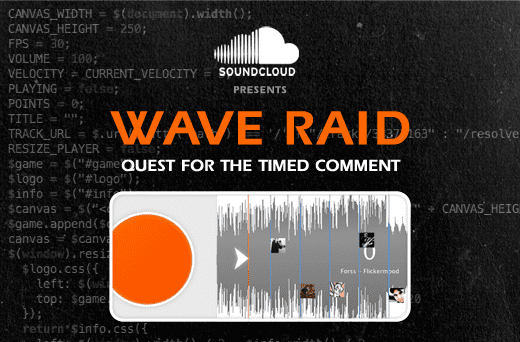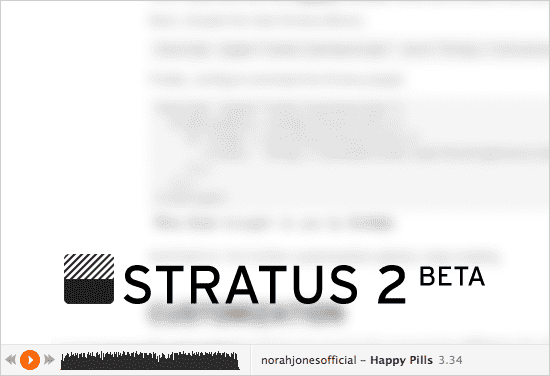SocialFolders Releases SoundCloud Ruby Gem
July 6th, 2012 by Paul OsmanThere are many approaches to building libraries that wrap HTTP APIs. For many of our officially supported SDKs we chose to build light wrappers around HTTP client libraries with a few added features to make it easier to work with the SoundCloud API. This approach has a few benefits. It guarantees a certain consistency and is relatively easy to maintain. It’s also fairly future proof. Changes in the HTTP API do not typically require updates to client libraries.
Sometimes however, you might be looking for something a bit more feature-full, or with more abstraction from our HTTP API. That’s why I was really happy to see that the great folks at SocialFolders built an alternative SoundCloud Ruby gem and released it to the public. You can check out their blog post about it or go straight to the source on GitHub.
Waveforms, Let's Talk About Them
June 26th, 2012 by leemartin
I’ve worked at SoundCloud for over two years now, and if there’s one thing I do a lot, it’s color waveforms. Tons of them. And, I’ve done it several different ways. Today, Johannes and I are pumped to announce a new JavaScript library called Waveform.js that will assist you in your coloring efforts. But first, let’s take some time to look back and learn from past techniques.
OceaniaSmashing Pumpkins use Premiere 1.5 BETA to debut "Oceania"
June 18th, 2012 by leemartin
Smashing Pumpkins are using a BETA of the next version of Premiere to debut their new record “Oceania.” Here’s what’s new about the app.
Create rich media experiences using timed comments
April 11th, 2012 by Johannes WagenerIn the last weeks we got pretty excited about the idea of using timed comments to create and script rich media experiences. Imagine being able to trigger all kinds of visualizations & interactions for a timed comment while playing a track.

Desktop Sharing Kits for OS X and Windows
April 10th, 2012 by Amir ShaikhLast week we announced a new integration with Ableton Live 8, that lets you easily share your sounds from within Ableton Live to SoundCloud. Today we’re making the technology behind that integration available to everyone through our new Desktop Sharing Kits.

Wave Raid powered by Timed Comments
April 5th, 2012 by Lee MartinOne of the SoundCloud API’s most powerful features is the timed comment. At its core it seems simple enough: a piece of text associated with a point in time for a particular track. But where you see timed opinions, I see a light-weight game scripting engine.
So when Johannes Wagener told me he was adding an ontimedcomments event to our JS SDK, I immediately began work on Wave Raid: Quest for the Timed Comment.
Developer Contest: SoundCloud + Acapela Group Mashup
April 4th, 2012 by Paul OsmanSoundCloud is teaming up with Acapela Group for our first Developer Contest. Acapela Group offers amazing text to speech solutions and have a variety of SDKs so you can write apps that create sound files using one of their voices (including hip-hop and country!). Take a listen to some sample voices.
We’re calling on our developer community to mashup SoundCloud and Acapela. Show us what you can do using a text to speech service with the best audio content platform on the web. Maybe you want to have your email read (or sung!) to you layered on some instrumental or drum tracks. We think there are loads of options for making interesting and accessible apps using these two services.
HTML5 Widget API
March 22nd, 2012 by Alexander KovalevToday we’re officially announcing our JavaScript API for the new HTML5 SoundCloud Widget. To use it, just insert the script tag on a page where you’re using our HTML5 Widget.
<script src="https://w.soundcloud.com/player/api.js" type="text/javascript"></script>What does it permit?
Access and control the properties of HTML5 Widget
<iframe id="sc-widget" src="https://w.soundcloud.com/player/?url=https://api.soundcloud.com/users/1539950/favorites" width="100%" height="465" scrolling="no" frameborder="no"></iframe>
<script src="https://w.soundcloud.com/player/api.js" type="text/javascript"></script>
<script type="text/javascript">
(function(){
var widgetIframe = document.getElementById('sc-widget'),
widget = SC.Widget(widgetIframe);
widget.bind(SC.Widget.Events.READY, function() {
widget.bind(SC.Widget.Events.PLAY, function() {
// get information about currently playing sound
widget.getCurrentSound(function(currentSound) {
console.log('sound ' + currentSound.get('') + 'began to play');
});
});
// get current level of volume
widget.getVolume(function(volume) {
console.log('current volume value is ' + volume);
});
// set new volume level
widget.setVolume(50);
// get the value of the current position
});
}());
</script>Load widgets
<iframe id="sc-widget" width="100%" height="166" scrolling="no" frameborder="no" src="https://w.soundcloud.com/player/?url=http%3A%2F%2Fapi.soundcloud.com%2Ftracks%2F1848538&show_artwork=true"></iframe>
<script src="https://w.soundcloud.com/player/api.js" type="text/javascript"></script>
<script type="text/javascript">
(function(){
var widgetIframe = document.getElementById('sc-widget'),
widget = SC.Widget(widgetIframe),
newSoundUrl = 'https://api.soundcloud.com/tracks/13692671';
widget.bind(SC.Widget.Events.READY, function() {
// load new widget
widget.bind(SC.Widget.Events.FINISH, function() {
widget.load(newSoundUrl, {
show_artwork: false
});
});
});
}());
</script>Resources
- take a look at our documentation for more details and technical descriptions
- check out our playground to get an overview of functionalities provided by the API
Feedback
If you’ve got a suggestion, found a bug, please let us…
Stratus 2 BETA
March 12th, 2012 by leemartinStratus is a jQuery powered SoundCloud player that lives at the bottom (or top) of your website or blog. In version 2, we’ve rebuilt Stratus from the ground up to include many requested features, a nicer aesthetic, and a much easier installation.
Pumped? Yeh, me too. Here’s how to participate in the BETA:
Moving API Support to Stack Overflow
March 7th, 2012 by Paul OsmanThe SoundCloud Developer Community has grown immensely. We have over ten thousand registered applications and over three hundred showcased in our App Gallery. Our goal as the Platform Team is to provide the best API tools possible, while also providing support and inspiration. So far, our primary channels have been this blog, our Twitter account, and our mailing list, hosted on Google Groups.
In the coming months, you can expect some changes as we retool to accommodate the growth of our developer community. We are revisiting everything and doubling down on our efforts to provide the best, most accessible platform possible for building amazing applications that use sound in exciting new ways on the web.


